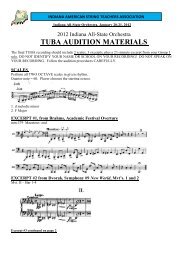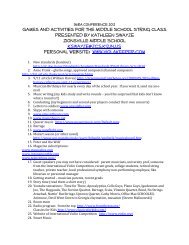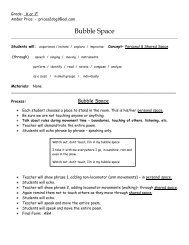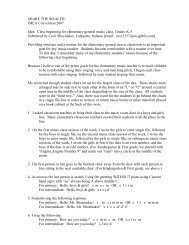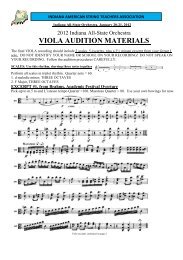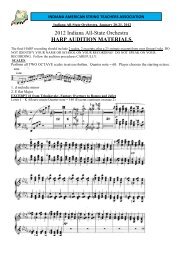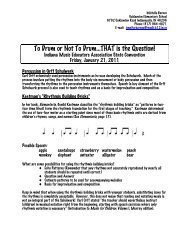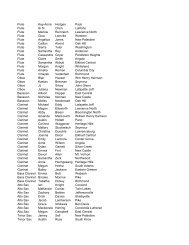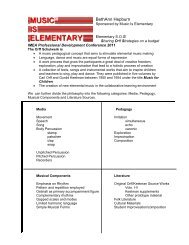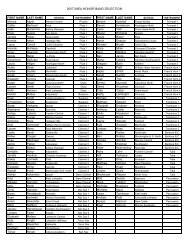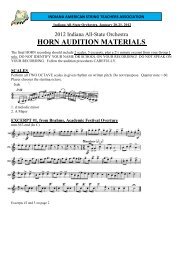no child left on his or her behind - Indiana Music Education ...
no child left on his or her behind - Indiana Music Education ...
no child left on his or her behind - Indiana Music Education ...
You also want an ePaper? Increase the reach of your titles
YUMPU automatically turns print PDFs into web optimized ePapers that Google loves.
HOW DO YOU DOO-TEE<br />
(Australia)<br />
T<strong>his</strong> hum<strong>or</strong>ous music game is a communal greeting activity d<strong>on</strong>e regularly at<br />
programs of the nati<strong>on</strong>al Australian family music associati<strong>on</strong> called "Parents f<strong>or</strong><br />
<strong>Music</strong>." It was presented in the U.S. at the 1994 American Orff-Schulwerk<br />
c<strong>on</strong>ference by André de Quadros, currently a Bost<strong>on</strong>-area music educat<strong>or</strong>, who<br />
was teaching in Australia at the time.<br />
<strong>Music</strong>, Video/DVD: Although it is usually a speech piece, a rec<strong>or</strong>ding -- complete<br />
with digiridoo-- is included in Silver Burdett Ginn’s series, Making <strong>Music</strong>, Grade<br />
4. In additi<strong>on</strong>, ―How Do You Doo-tee‖ is dem<strong>on</strong>strated <strong>on</strong> Sanna’s purple<br />
video/DVD, M<strong>or</strong>e Fav<strong>or</strong>ite Folk Dances f<strong>or</strong> Kids & Teac<strong>her</strong>s.<br />
Movement Pattern<br />
(1) Start in a closed circle, your own arms crossed <strong>on</strong>e over the ot<strong>her</strong>, holding hands<br />
with people <strong>on</strong> eit<strong>her</strong> side. Turn head to <strong>on</strong>e side. Say:<br />
"How do you doo-tee, how do you doo-tee, how do you do today [to-DYE]?"<br />
(2) Change crossed arms with the ot<strong>her</strong> arm <strong>on</strong> top, and turn head the ot<strong>her</strong> way.<br />
Say:<br />
"Do you live w<strong>her</strong>e you used to live, <strong>or</strong> have you shifted away [ah-WHY]?"<br />
(3) Change crossed arms to the first c<strong>on</strong>figurati<strong>on</strong>, and turn head the first way.<br />
Say:<br />
"I'm s<strong>or</strong>ry you're so disagreeable--I <strong>on</strong>ly stopped to say [SIGH],"<br />
(4) Drop arms and move quickly to a<str<strong>on</strong>g>no</str<strong>on</strong>g>t<strong>her</strong> place in the circle, while saying:<br />
"How do you doo-tee, how do you doo-tee, how do you do today [to-DYE]!"<br />
As you rejoin the circle, cross your arms and begin again.<br />
It adds even m<strong>or</strong>e excitement if the chant increases in tempo with each repetiti<strong>on</strong>.<br />
_______________________<br />
PRESENTED BY SANNA LONGDEN.<br />
Notes by Sanna L<strong>on</strong>gden © 2005, based <strong>on</strong> pattern taught by André de Quadros.



